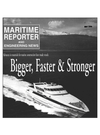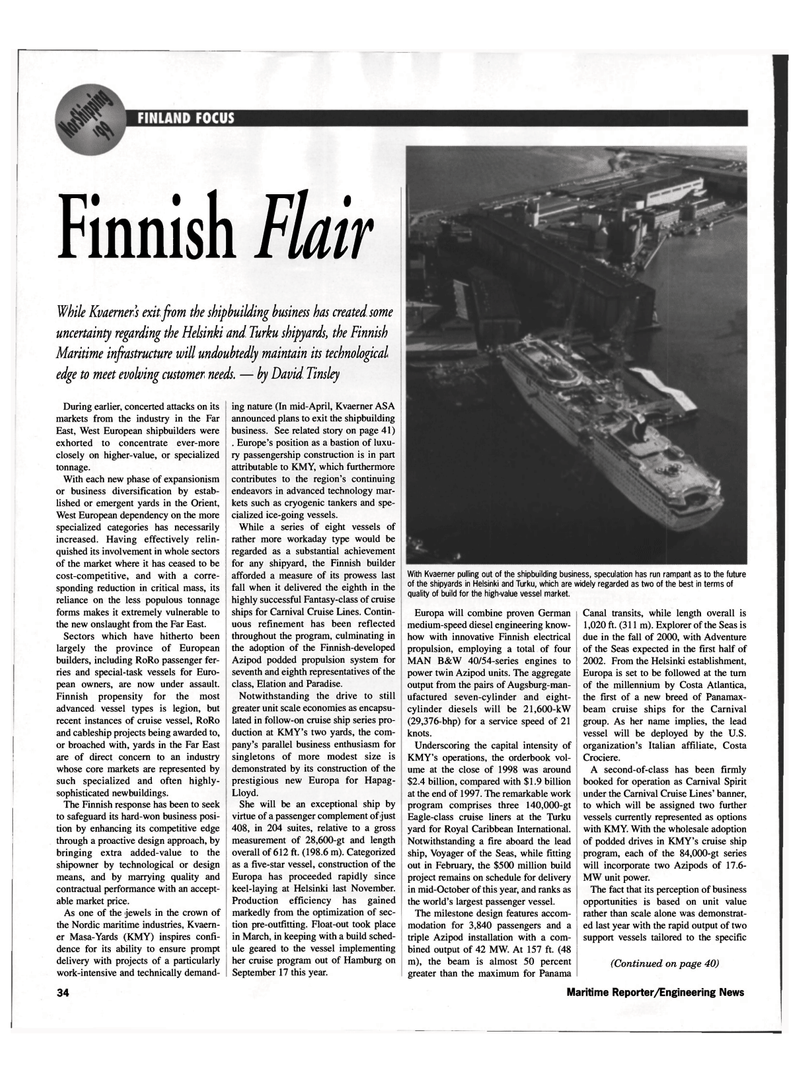
Page 34: of Maritime Reporter Magazine (May 1999)
Read this page in Pdf, Flash or Html5 edition of May 1999 Maritime Reporter Magazine
Finnish Fkir
While Kvaerner's exit from the shipbuilding business has created some uncertainty regarding the Helsinki and Turku shipyards, the Finnish
Maritime infrastructure will undoubtedly maintain its technological edge to meet evolving customer needs. — by David Tinsley
With Kvaerner pulling out of the shipbuilding business, speculation has run rampant as to the future of the shipyards in Helsinki and Turku, which are widely regarded as two of the best in terms of quality of build for the high-value vessel market.
During earlier, concerted attacks on its markets from the industry in the Far
East, West European shipbuilders were exhorted to concentrate ever-more closely on higher-value, or specialized tonnage.
With each new phase of expansionism or business diversification by estab- lished or emergent yards in the Orient,
West European dependency on the more specialized categories has necessarily increased. Having effectively relin- quished its involvement in whole sectors of the market where it has ceased to be cost-competitive, and with a corre- sponding reduction in critical mass, its reliance on the less populous tonnage forms makes it extremely vulnerable to the new onslaught from the Far East.
Sectors which have hitherto been largely the province of European builders, including RoRo passenger fer- ries and special-task vessels for Euro- pean owners, are now under assault.
Finnish propensity for the most advanced vessel types is legion, but recent instances of cruise vessel, RoRo and cableship projects being awarded to, or broached with, yards in the Far East are of direct concern to an industry whose core markets are represented by such specialized and often highly- sophisticated newbuildings.
The Finnish response has been to seek to safeguard its hard-won business posi- tion by enhancing its competitive edge through a proactive design approach, by bringing extra added-value to the shipowner by technological or design means, and by marrying quality and contractual performance with an accept- able market price.
As one of the jewels in the crown of the Nordic maritime industries, Kvaern- er Masa-Yards (KMY) inspires confi- dence for its ability to ensure prompt delivery with projects of a particularly work-intensive and technically demand- ing nature (In mid-April, Kvaerner ASA announced plans to exit the shipbuilding business. See related story on page 41) . Europe's position as a bastion of luxu- ry passengership construction is in part attributable to KMY, which furthermore contributes to the region's continuing endeavors in advanced technology mar- kets such as cryogenic tankers and spe- cialized ice-going vessels.
While a series of eight vessels of rather more workaday type would be regarded as a substantial achievement for any shipyard, the Finnish builder afforded a measure of its prowess last fall when it delivered the eighth in the highly successful Fantasy-class of cruise ships for Carnival Cruise Lines. Contin- uous refinement has been reflected throughout the program, culminating in the adoption of the Finnish-developed
Azipod podded propulsion system for seventh and eighth representatives of the class, Elation and Paradise.
Notwithstanding the drive to still greater unit scale economies as encapsu- lated in follow-on cruise ship series pro- duction at KMY's two yards, the com- pany's parallel business enthusiasm for singletons of more modest size is demonstrated by its construction of the prestigious new Europa for Hapag-
Lloyd.
She will be an exceptional ship by virtue of a passenger complement of just 408, in 204 suites, relative to a gross measurement of 28,600-gt and length overall of 612 ft. (198.6 m). Categorized as a five-star vessel, construction of the
Europa has proceeded rapidly since keel-laying at Helsinki last November.
Production efficiency has gained markedly from the optimization of sec- tion pre-outfitting. Float-out took place in March, in keeping with a build sched- ule geared to the vessel implementing her cruise program out of Hamburg on
September 17 this year.
Europa will combine proven German medium-speed diesel engineering know- how with innovative Finnish electrical propulsion, employing a total of four
MAN B&W 40/54-series engines to power twin Azipod units. The aggregate output from the pairs of Augsburg-man- ufactured seven-cylinder and eight- cylinder diesels will be 21,600-kW (29,376-bhp) for a service speed of 21 knots.
Underscoring the capital intensity of
KMY's operations, the orderbook vol- ume at the close of 1998 was around $2.4 billion, compared with $1.9 billion at the end of 1997. The remarkable work program comprises three 140,000-gt
Eagle-class cruise liners at the Turku yard for Royal Caribbean International.
Notwithstanding a fire aboard the lead ship, Voyager of the Seas, while fitting out in February, the $500 million build project remains on schedule for delivery in mid-October of this year, and ranks as the world's largest passenger vessel.
The milestone design features accom- modation for 3,840 passengers and a triple Azipod installation with a com- bined output of 42 MW. At 157 ft. (48 m), the beam is almost 50 percent greater than the maximum for Panama
Canal transits, while length overall is 1,020 ft. (311 m). Explorer of the Seas is due in the fall of 2000, with Adventure of the Seas expected in the first half of 2002. From the Helsinki establishment,
Europa is set to be followed at the turn of the millennium by Costa Atlantica, the first of a new breed of Panamax- beam cruise ships for the Carnival group. As her name implies, the lead vessel will be deployed by the U.S. organization's Italian affiliate, Costa
Crociere.
A second-of-class has been firmly booked for operation as Carnival Spirit under the Carnival Cruise Lines' banner, to which will be assigned two further vessels currently represented as options with KMY. With the wholesale adoption of podded drives in KMY's cruise ship program, each of the 84,000-gt series will incorporate two Azipods of 17.6-
MW unit power.
The fact that its perception of business opportunities is based on unit value rather than scale alone was demonstrat- ed last year with the rapid output of two support vessels tailored to the specific (Continued on page 40) 34 Maritime Reporter/Engineering News

 33
33

 35
35
